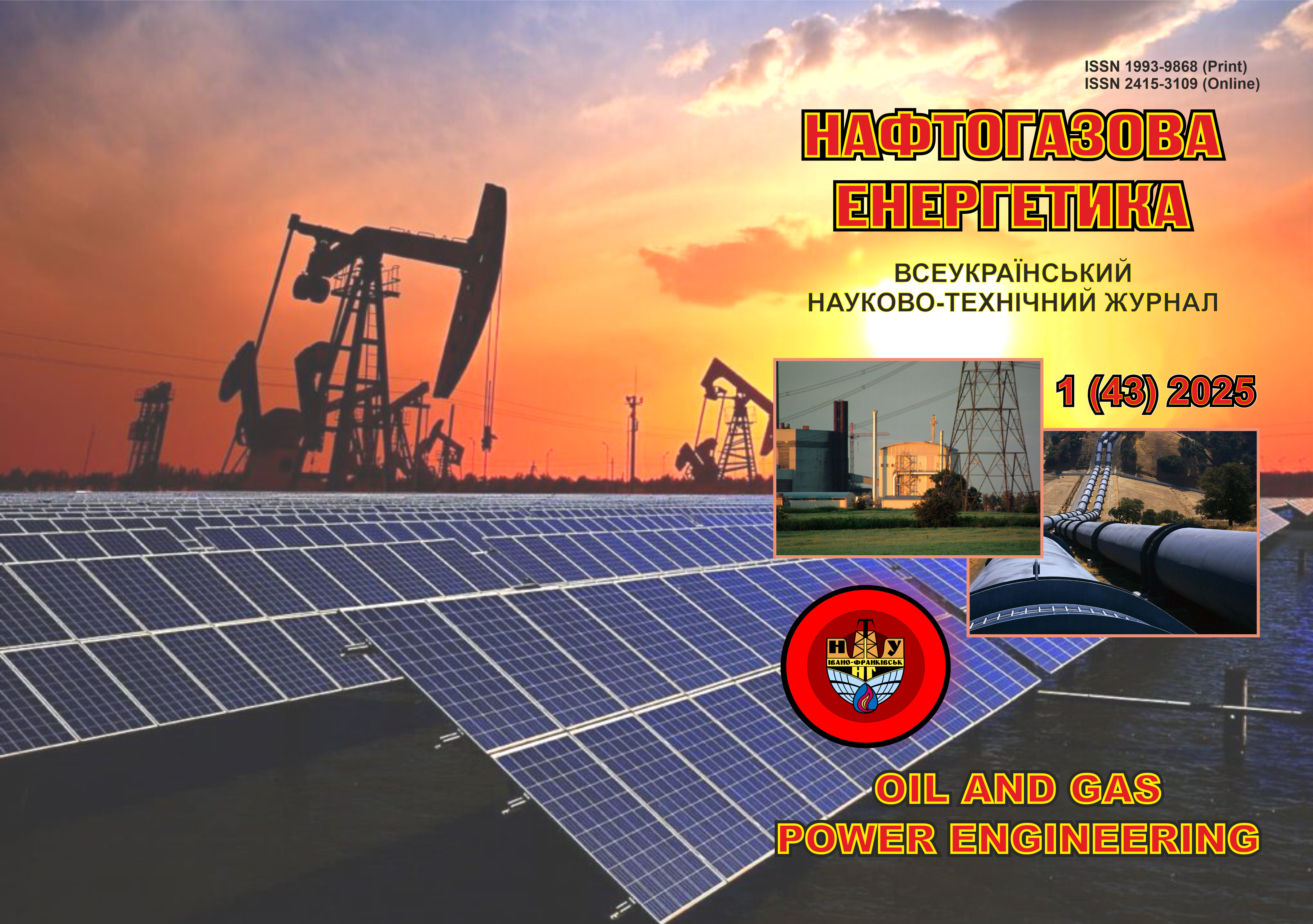SIMULATION MODELING OF BLOWDOWNS OF WELLS AND GAS GATHERING PIPELINES OF GAS-CONDENSATE FIELDS
DOI:
https://doi.org/10.31471/1993-9868-2025-1(43)-71-86Keywords:
gas-condensate field; modeling; flow; liquid; outflow velocity; flow rate.Abstract
Three-dimensional modelling of the physical process of a gas–liquid mixture leaking from a pipeline into the atmosphere was carried out under conditions corresponding to the actual parameters observed during the blowing of gathering pipelines and wells in gas and gas-condensate fields in Ukraine. In the Ansys R1 Student software environment, a three-dimensional model comprising zones of atmospheric and excess pressure was constructed. These were represented by a rectangular parallelepiped (with dimensions of 5 m by 3 m by 3 m) and a pipeline with an inner diameter of 77 mm and a length of 1 m, respectively. The VOF (Volume of Fluid) mathematical model, which is based on solving a system of mass conservation, momentum and volume fraction transport equations closed by a two-parameter k-ε turbulence model, was selected for the simulation. This model enables the prediction of multiphase flow dynamics with distinctly separated phases, as is typical when blowing down liquid with gas.Various values of excess pressure (0.10–0.35 MPa) and liquid volume fraction (α_l = 0.00–0.50) were assigned at the inlet boundary of the pipeline to perform the calculations. The outflow velocity, Mach number and gas flow rate were determined from the simulation results for each set of boundary input data. Additionally, to obtain comprehensive information on the effect of liquid on gas flow rate and for detailed analysis, the graphical interface of the Fluid Flow (Fluent) module was used to visualise velocity distribution contours and the liquid volume fraction along the 3D model of the pipeline and the atmospheric pressure zone. By examining the modelling results, the study identified regularities in the influence of the liquid phase on the gas flow rate during the pressurised outflow of a gas-liquid mixture from the pipeline into the atmosphere. It also revealed the primary factors leading to a reduced gas flow rate when the liquid volume fraction in the flow increases. It was confirmed that additional coefficients need to be developed and integrated into current gas loss calculation methodologies for blowing, in order to account for the presence of liquid in the gas flow.
Downloads
References
Doroshenko Ya.V. Modeliuvannia vytikan hazu z hazoprovodiv v avariinykh sytuatsiiakh. Visnyk Vinnytskoho politekhnichnoho universytetu. 2020. № 3 (150). P. 22-28. [in Ukrainian]
Hrudz V.Ya., Hrudz Ya.V, Drin N.Ya., Demianchuk Ya.M. Vplyv filtratsiinoho oporu gruntu na intensyvnist avariinykh vytokiv iz hazoprovodu. Rozvidka ta rozrobka naftovykh i hazovykh rodovyshch. 2015. № 2. P. 68-73. [in Ukrainian]
Matiko F., Hnatiuk O. Hazodynamichni yavyshcha u vytratomirakh zminnoho perepadu tysku. Zbirnyk materialiv konferentsii "Suchasni tekhnolohii v enerhetytsi". 2017. P. 158-160. [in Ukrainian]
Garoosi F., Hooman K. Numerical simulation of multiphase flows using an enhanced Volume-of-Fluid (VOF) method. International Journal of Mechanical Sciences. 2022. Vol. 215. P. 106-131.
Harlow F.H., Amsden A.A. A Numerical Fluid Dynamics Calculation Method for All Flow Speeds. Journal of Computational Physics. 1971. Vol. 8. Issue 2. P. 197-213.
Meziou A., Chaari M., Franchek M. et al. Low-Dimensional Modeling of Transient Two-Phase Flow in Pipelines. Journal of Dynamic Systems, Measurement, Control. 2016. Vol. 138. Issue 10. 101008.
Meziou A., Khan Z., Wassar, T. et al. Dynamic Modeling of Two-Phase Gas/Liquid Flow in Pipelines. SPE Journal. 2019. Vol. 24. Issue 5. P. 2239-2263.
Tzotzi C., Bontozoglou B., Andritsos N., Vlachogiannis M. Effect of Fluid Properties on Flow Patterns in Two-Phase Gas-Liquid Flow in Horizontal and Downward pipes. Industrial & Engineering Chemistry Research. 2011. Vol. 50. Issue 2. P. 645-655.
Yaqub M.W., Marappagounder R., Rusli R. et al. Review on Gas–Liquid–Liquid Three–Phase Flow Patterns, Pressure Drop, and Liquid Holdup in Pipelines. Chemical Engineering Research and De-sign. 2020. Vol. 159. P. 505-528.
Henry R.E., Fauske H.K. The Two-Phase Critical Flow of One-Component Mixtures in Noz-zles, Orifices, and Short Tubes. Journal of Heat Transfer. 1971. Vol. 93. Issue 2. P. 179-187.
Ghorai S., Nigam K.D.P. CFD Modeling of Flow Profiles and Interfacial Phenomena in Two-Phase Flow in Pipes. Chemical Engineering and Processing: Process Intensification. 2006. Vol. 45. Issue 1. P. 55-65.
Masolwa A.M. Evaluation of Models to Predict Liquid Loading in Gas Wells: Master Thesis. Trondheim: NTNU, 2018. 77 p.
Ke W., Hou L., Wang L. et al. Research on Critical Liquid-Carrying Model in Wellbore and Laboratory Experimental Verification. Processes. 2021. Vol. 9, №6. 923.
Motamedian E., Kasiri N., Ghaemi A. Modeling Two-Phase Flow in Horizontal Pipe Bends. Hydrocarbon Process. 2007. 86 (9). P. 145-150.
Döß A., Schubert M., Wiedemann P. et al. Flow Morphologies in Straight and Bent Horizontal Pipes. ACS Engineering Au. 2021. Vol. 1. Issue 1. P. 39-49.
Yurishchev A., Brauner N., Ullmann A. Modeling of high-pressure transient gas-liquid flow in M-shaped jumpers of subsea gas production systems. International Journal of Multiphase Flow. 2024. Vol. 181. 105003.
Hirt C. W., Nichols B. D. Volume of Fluid (VOF) Method for the Dynamics of Free Bounda-ries. Journal of Computational Physics. 1981. Vol. 39. Issue 1. P. 201-225.
Introduction to Theoretical and Computational Fluid Dynamics / edited by S. Pozrikidis. 2nd edn. New York: Oxford University Press, 2013. 1243 p.
White F. M. Fluid Mechanics: 8th edition. New York: McGraw-Hill Education, 2016. 864 p.
Anderson J. D. Computational Fluid Dynamics: The Basics with Applications. New York: McGraw-Hill, 1995. 547 p.
Doroshenko Ya. V., Marko T. I., Doroshenko T. I. Doslidzhennia dynamiky rukhu baha-tofaznykh potokiv fasonnymy elementamy obv’iazky kompresornoi stantsii mahistralnoho hazoprovodu. International scientific journal. 2016. № 7. P. 68-77. [in Ukrainian]
Panton R. L. Incompressible Flow: Fourth edition. New Jersey: John Wiley & Sons, Inc., 2013. 878 p.
Vlachopoulos J. Fundamentals of Fluid Mechanics: Revised internet edition. Hamilton: Polydy-namics Inc., 2016. 816 p.
Brackbill J. U., Kothe D. B., Zemach C. A Continuum Method for Modeling Surface Tension. Journal of Computational Physics. 1992. Vol. 100. Issue 2. P. 335-354.
Ubbink O. Numerical Prediction of Two Fluid Systems With Sharp Interfaces: PhD thesis. Lon-don: University of London, 1997. 193 p.
Versteeg H. K., Malalasekera W. An Introduction to Computational Fluid Dynamics. The Finite Volume Method. Harlow : Longman Scientific & Technical, 1995. 257 p.
Ferziger J. H., Perić M., Street R. L. Computational Methods for Fluid Dynamics: Fourth edi-tion. Cham: Springer Nature Switzerland AG, 2020. 596 p.
Issa R. I. Solution of Implicitly Discretized Fluid Flow Equations by Operator Splitting. Journal of Computational Physics. 1986. Vol. 62. Issue 1. P. 40-65.
Holubenko V. P., Stetsiuk S. M., Filipchuk O. O. Analiz metodyk vyznachennia vtrat hazu pid chas produvan shleifiv i sverdlovyn dlia vydalennia ridynnykh nakopychen. Naftohazova enerhetyka. 2023. № 1. P. 24-34. [in Ukrainian]
Downloads
Published
How to Cite
Issue
Section
License
Copyright (c) 2025 Oil and Gas Power Engineering

This work is licensed under a Creative Commons Attribution-ShareAlike 4.0 International License.


.png)






1.png)









